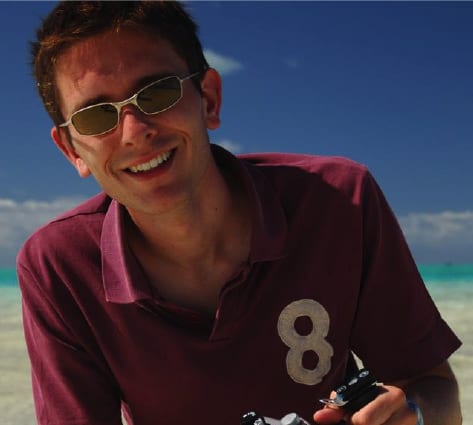A big shout out to G and Lisa for being amazing cruise directors. Crew: BEST CREW!!! Idy is the greatest divemaster we had the pleasure to dive with. He is attentive, safety orientated and knowledgeable. Anto and Kadek made our dining experience a total joy. Food: Excellent, very yummy! The kitchen staff was wonderful even about little things like no garlic in my vegetables ;)
BIOGRAPHY / Vanessa Knutson

Vanessa Knutson recently completed her master’s degree working on one of the most challenging and fascinating groups of nudibranchs, the genus Gymnodoris (who have the unusual habit of eating other nudibranchs while they’re still alive). Her master’s advisor was Terry Gosliner, the world’s foremost sea slug expert and one of the authors of the spectacular Indo Pacific Nudibranchs and Sea Slugs field guide.
During the last couple of years, Vanessa has done fieldwork in Papua New Guinea, Australia and the Philippines, including participating in two major multidisciplinary biodiversity expeditions.
Through her work, she has uncovered about 50 new species of Gymnodoris! She is currently working on naming and describing many of these unknown species and figuring out their diets, which consist of other sea slug species.
Her knowledge extends to other Indo-Pacific nudibranchs, having recently served as one of the three sea slug experts on a 6 week expedition to Papua New Guinea where they collected and identified over 300 species of slugs, including many new species!
Vanessa has been diving for 10 years for recreation and research and enjoys underwater photography. She’s also likely to be the only person baking NUDI COOKIES (as the photo on the left shows)!
- See a sample of some of Vanessa’s research at WWW.CalAcademy.ORG
- Or if you’re curious about Gymnodoris’ ghoulish appetite take a look at this NUDI VIDEO
- Keep up to date with this specific trip at our FACEBOOK EVENT PAGE
CRUISE OVERVIEW
Set sail from the port of Labuanbajo on the west of Flores Island, on a 9-day/8-night cruise, to explore all the famous dive sites of Komodo (ending back in Labuanbajo). The Komodo National Park offers excellent muck diving, but also outstanding pelagic action. Whether its nudibranchs and rhinopias you’re after, or manta rays and schooling fish, this cruise really has it all.
This famous dive destination is located within the Coral Triangle, an area that boasts the world’s highest marine biodiversity. Situated 200 nautical miles east of Bali, in the Lesser Sunda Islands, the Komodo National Park has a total land area of 75,000 hectares and encompasses a number of islands, the largest of which is Komodo (34,000 hectares). A total of 112,500 hectares of the surrounding waters is also under the jurisdiction of the park rangers, allowing for the protection of over 1,000 species of fish and hundreds of different corals.
Komodo’s dive sites stretch from the warm waters of the Flores Sea in the north to the chillier waters down south in the Indian Ocean and vary from gentle coral slopes to heart-pounding adrenaline thrill rides. The underwater terrain presents many contrasts as well, with sheer cliff walls, pinnacles, sandy flat bottoms, underwater plateaus, slopes, caves, swim – throughs, channels, all with differing colours, sizes and types of both hard and soft corals.
Along the way, dive around Moyo island, Satonda and Bima. Relax as we cruise through the Komodo-Flores channel. Two popular sites at Gili Lawa Laut, called Crystal Rock and Castle Rock, will offer opportunities for critter spotting as well as big fish action. In fact, the dive site of Castle Rock is a nice opportunity to try out a ‘reef-hook’ dive as you secure yourself to the rock and float in the current, watching the schooling fish and predator/prey action! Next, dive around Rinca island and head on land to meet the Komodo dragons.
Currents in this area can be quite strong and we have to dive according to the tides, but with so many great sites to choose from we can always adapt the schedule for the best diving. Try something unusual at Sangeang island as we dive in the shadow of an active volcano…feeling the hot springs bubbling up under the sand.
In Komodo, it’s all about diversity: exhilarating drift diving, interesting muck diving, encounters with pelagics (mantas, sharks, whale sharks, sunfish), macro attractions (pygmy seahorses, blue-ringed octopus, frogfish, ghost pipefish), shallow reefs, walls, pinnacles, seamounts, pristine hard/soft corals.
In general the water temperature in the Komodo area is around 26-28+ (78-82F+) so usually a 3-5mm wetsuit is fine, but the southern dive sites in Komodo can drop down to 24-26C (75-78F) so some guests prefer a 5mm with hood. For repetitive diving days you may start to notice the cooler thermoclines more than usual, so prefer to wear a slightly thicker wetsuit and/or a hood, but usually 5mm is sufficient. We don’t recommend gloves as this can encourage divers to touch corals or delicate reef areas, but for night dives, where you could be more likely to bump into fire coral etc (or the 2 days of diving in south Komodo), many divers do prefer earning a full length suit and hood/gloves.